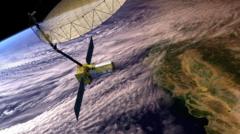The Nisar satellite, slated for launch from the Satish Dhawan Space Centre in India, represents a groundbreaking collaboration between NASA and the Indian Space Research Organisation (ISRO). This advanced Earth-observation satellite is designed to meticulously monitor land, sea, and ice sheet changes on Earth, marking a significant step in disaster preparedness for both nations and the global community at large.
Weighing 2,392 kg, Nisar is expected to be launched at 17:40 India time (12:10 GMT) on Wednesday. NASA has labeled it as the "most sophisticated radar we've ever built," capable of detecting even the most minute changes across the globe. It will be the first satellite to utilize two radar frequencies - NASA's L-band and ISRO's S-band - to achieve its monitoring capabilities. Once in its sun-synchronous polar orbit, Nisar will pass over the same locations every 12 days, providing invaluable data for climate change tracking and disaster management.
Former NASA scientist Mila Mitra underscored the importance of repeated scans, stating that the data collected will support ground stations in disaster readiness. The satellite's ability to monitor Earth’s surface changes due to both natural and human activities will facilitate early warnings for potential threats, including earthquakes, landslides, glacier melting, and human-induced environmental shifts.
NASA's Director of Earth Sciences, Karen St Germain, highlighted the unique aspect of Nisar being developed collaboratively by scientists from opposite ends of the globe during the Covid-19 pandemic. ISRO Chairman V Narayanan referred to Nisar as a "life-saving satellite" symbolizing India's advancing position in global space leadership, calling the launch a "great day for India."
Indian Science Minister Jitendra Singh hailed the project as a definitive moment in India-US space cooperation, framing Nisar as a "scientific handshake" with the world. This launch follows notable achievements in India’s space exploration, including the historic Moon landing near the lunar south pole and plans for its first human space flight, Gaganyaan, aimed for 2027.
Weighing 2,392 kg, Nisar is expected to be launched at 17:40 India time (12:10 GMT) on Wednesday. NASA has labeled it as the "most sophisticated radar we've ever built," capable of detecting even the most minute changes across the globe. It will be the first satellite to utilize two radar frequencies - NASA's L-band and ISRO's S-band - to achieve its monitoring capabilities. Once in its sun-synchronous polar orbit, Nisar will pass over the same locations every 12 days, providing invaluable data for climate change tracking and disaster management.
Former NASA scientist Mila Mitra underscored the importance of repeated scans, stating that the data collected will support ground stations in disaster readiness. The satellite's ability to monitor Earth’s surface changes due to both natural and human activities will facilitate early warnings for potential threats, including earthquakes, landslides, glacier melting, and human-induced environmental shifts.
NASA's Director of Earth Sciences, Karen St Germain, highlighted the unique aspect of Nisar being developed collaboratively by scientists from opposite ends of the globe during the Covid-19 pandemic. ISRO Chairman V Narayanan referred to Nisar as a "life-saving satellite" symbolizing India's advancing position in global space leadership, calling the launch a "great day for India."
Indian Science Minister Jitendra Singh hailed the project as a definitive moment in India-US space cooperation, framing Nisar as a "scientific handshake" with the world. This launch follows notable achievements in India’s space exploration, including the historic Moon landing near the lunar south pole and plans for its first human space flight, Gaganyaan, aimed for 2027.



















